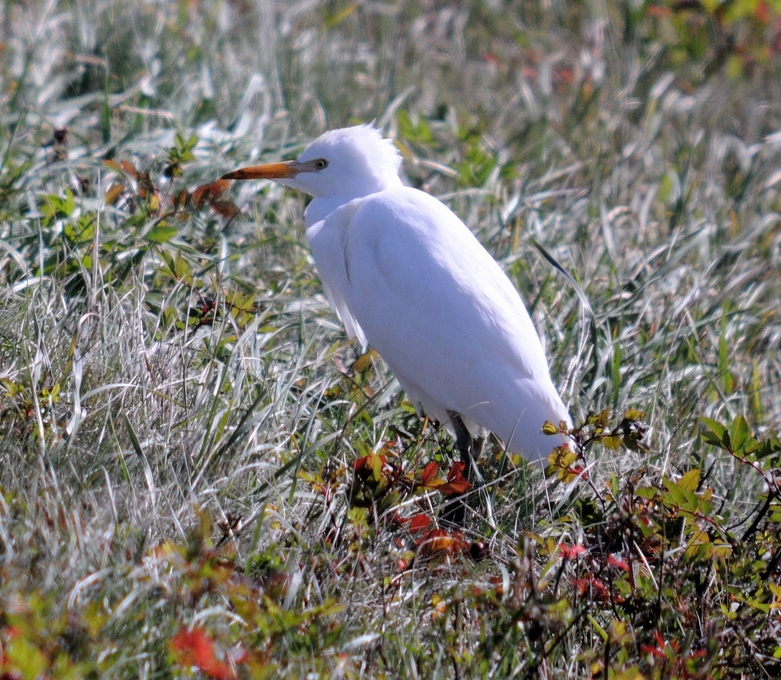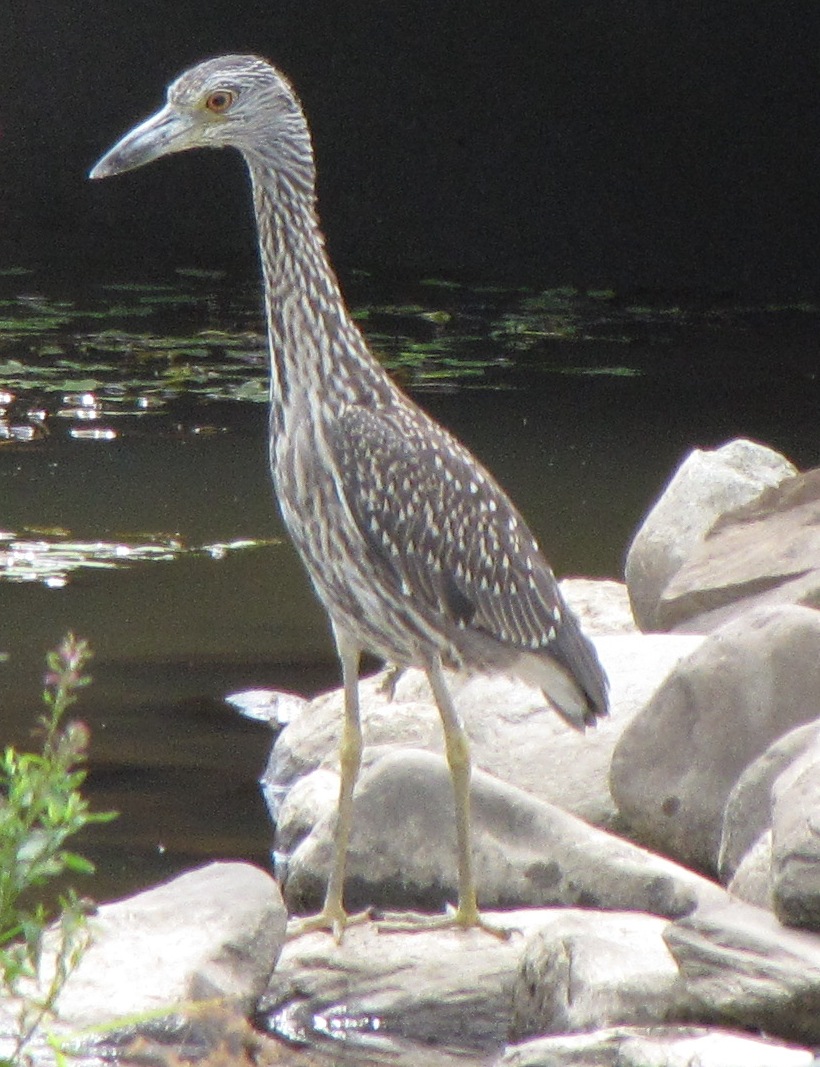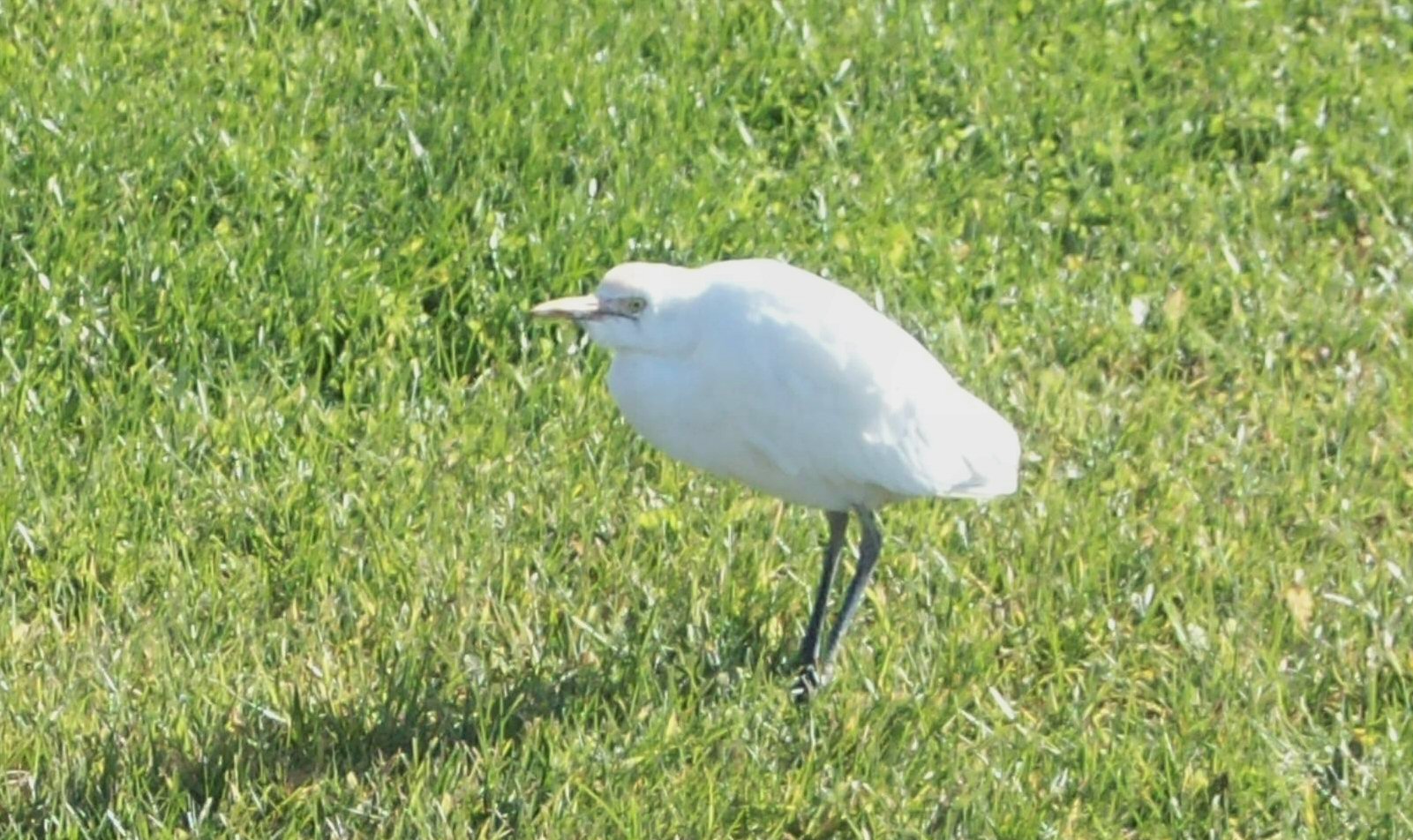November 17, 2010 at 9:52 am
[caption id="attachment_444" align="alignleft" width="300" caption="Cattle egret observed feeding on grasshoppers on Bailey Island in Harpswell. (Photo by Jonathan Mays)"] [/caption]
Fall is upon us and winter is certainly not far behind. [Snow was flying as early as Halloween at my house this year!] As the cold weather moves in, herons typically move out…of Maine, that is. I say typically because there are definitely stragglers here and there. But, what’s more interesting is that after herons breed they typically disperse in all directions before heading south for the winter. In the scientific literature, this is dubbed “nondirectional wandering.” This is why we can see such rarities as yellow-crowned night-herons and cattle egrets in the fall in various parts of the state. We don’t currently have either of these species nesting in the state – at least not that I am aware of. And they certainly are not known to breed north of Maine.
A few of the most recent sightings of interest have been cattle egrets in Gorham, Harpswell, Burnham, Pittsfield, Belfast, Vinalhaven, Chester, and Easton. Such an abundance of sightings may suggest nearby breeding, but don’t be fooled so quickly. The only data I have regarding breeding cattle egrets in Maine is between 1989 and 1995, when up to 3 pairs nested on Stratton Island in Saco Bay. National Audubon manages this island and keeps record of up to seven species of breeding herons there.
[caption id="attachment_449" align="alignleft" width="230" caption="A juvenile yellow-crowned night-heron seen at the Mt Hope Cemetary in Bangor in 2009."]
[/caption]
Fall is upon us and winter is certainly not far behind. [Snow was flying as early as Halloween at my house this year!] As the cold weather moves in, herons typically move out…of Maine, that is. I say typically because there are definitely stragglers here and there. But, what’s more interesting is that after herons breed they typically disperse in all directions before heading south for the winter. In the scientific literature, this is dubbed “nondirectional wandering.” This is why we can see such rarities as yellow-crowned night-herons and cattle egrets in the fall in various parts of the state. We don’t currently have either of these species nesting in the state – at least not that I am aware of. And they certainly are not known to breed north of Maine.
A few of the most recent sightings of interest have been cattle egrets in Gorham, Harpswell, Burnham, Pittsfield, Belfast, Vinalhaven, Chester, and Easton. Such an abundance of sightings may suggest nearby breeding, but don’t be fooled so quickly. The only data I have regarding breeding cattle egrets in Maine is between 1989 and 1995, when up to 3 pairs nested on Stratton Island in Saco Bay. National Audubon manages this island and keeps record of up to seven species of breeding herons there.
[caption id="attachment_449" align="alignleft" width="230" caption="A juvenile yellow-crowned night-heron seen at the Mt Hope Cemetary in Bangor in 2009."] [/caption]
In August of 2009, I had the delight of seeing a juvenile yellow-crowned night-heron right here in Bangor. Night-herons’ nocturnal habits make them more secretive than other herons and thus they may go unnoticed especially if there is only one pair nesting in an area. However, as of 2006, the nearest breeding site was in southern New York (Mid-Atlantic/New England/Maritimes Region (MANEM) Waterbird Conservation Plan). Certainly expansion of the species northward could have occurred since then. In fact, an extensive tendency for nondirectional wandering in cattle egrets is one of the keys to its successful range expansion from South Africa to North America only 60 years ago.
The reasons for nondirectional wandering are not clearly understood.
Birds may seek foraging areas where competition from other conspecifics (birds of the same species) is reduced. This makes sense when you consider that a moderately sized colony in Maine of 25 pairs of great blue herons may successfully fledge 75 young. Where are 50 adults and 75 young going to feed? Most likely the favorite feeding places of the parents don’t have enough wading room for the youngsters. Plus, herons can be quite territorial when it comes to prime feeding sites, with age and sex determining who’s dominant.
[caption id="attachment_456" align="alignleft" width="300" caption="A cattle egret seen in Easton on November 9th. (Photo by Jeff Saucier)"]
[/caption]
In August of 2009, I had the delight of seeing a juvenile yellow-crowned night-heron right here in Bangor. Night-herons’ nocturnal habits make them more secretive than other herons and thus they may go unnoticed especially if there is only one pair nesting in an area. However, as of 2006, the nearest breeding site was in southern New York (Mid-Atlantic/New England/Maritimes Region (MANEM) Waterbird Conservation Plan). Certainly expansion of the species northward could have occurred since then. In fact, an extensive tendency for nondirectional wandering in cattle egrets is one of the keys to its successful range expansion from South Africa to North America only 60 years ago.
The reasons for nondirectional wandering are not clearly understood.
Birds may seek foraging areas where competition from other conspecifics (birds of the same species) is reduced. This makes sense when you consider that a moderately sized colony in Maine of 25 pairs of great blue herons may successfully fledge 75 young. Where are 50 adults and 75 young going to feed? Most likely the favorite feeding places of the parents don’t have enough wading room for the youngsters. Plus, herons can be quite territorial when it comes to prime feeding sites, with age and sex determining who’s dominant.
[caption id="attachment_456" align="alignleft" width="300" caption="A cattle egret seen in Easton on November 9th. (Photo by Jeff Saucier)"] [/caption]
Another possibility is that during the onset of the breeding season, what otherwise may be a prime feeding area a bit further north may still be frozen over. After the breeding season, these food-rich areas are now available to any birds willing to make a side trip to the north, west, or east before finally going south for the winter.
A third possibility is that northern areas may have plenty of feeding areas, but not necessarily close to preferred habitat for nesting. After breeding is over, birds only have themselves to worry about and their worries are likely quite simple: food, water, and avoid predators and mistakes.
Whatever the reasons for their nondirectional wanderings, these birds are welcomed by Maine’s enthusiastic birders. Enjoy these sightings, for it won’t be long before the egrets and all other herons in the state steer their path directly southward.
[/caption]
Another possibility is that during the onset of the breeding season, what otherwise may be a prime feeding area a bit further north may still be frozen over. After the breeding season, these food-rich areas are now available to any birds willing to make a side trip to the north, west, or east before finally going south for the winter.
A third possibility is that northern areas may have plenty of feeding areas, but not necessarily close to preferred habitat for nesting. After breeding is over, birds only have themselves to worry about and their worries are likely quite simple: food, water, and avoid predators and mistakes.
Whatever the reasons for their nondirectional wanderings, these birds are welcomed by Maine’s enthusiastic birders. Enjoy these sightings, for it won’t be long before the egrets and all other herons in the state steer their path directly southward.
 [/caption]
Fall is upon us and winter is certainly not far behind. [Snow was flying as early as Halloween at my house this year!] As the cold weather moves in, herons typically move out…of Maine, that is. I say typically because there are definitely stragglers here and there. But, what’s more interesting is that after herons breed they typically disperse in all directions before heading south for the winter. In the scientific literature, this is dubbed “nondirectional wandering.” This is why we can see such rarities as yellow-crowned night-herons and cattle egrets in the fall in various parts of the state. We don’t currently have either of these species nesting in the state – at least not that I am aware of. And they certainly are not known to breed north of Maine.
A few of the most recent sightings of interest have been cattle egrets in Gorham, Harpswell, Burnham, Pittsfield, Belfast, Vinalhaven, Chester, and Easton. Such an abundance of sightings may suggest nearby breeding, but don’t be fooled so quickly. The only data I have regarding breeding cattle egrets in Maine is between 1989 and 1995, when up to 3 pairs nested on Stratton Island in Saco Bay. National Audubon manages this island and keeps record of up to seven species of breeding herons there.
[caption id="attachment_449" align="alignleft" width="230" caption="A juvenile yellow-crowned night-heron seen at the Mt Hope Cemetary in Bangor in 2009."]
[/caption]
Fall is upon us and winter is certainly not far behind. [Snow was flying as early as Halloween at my house this year!] As the cold weather moves in, herons typically move out…of Maine, that is. I say typically because there are definitely stragglers here and there. But, what’s more interesting is that after herons breed they typically disperse in all directions before heading south for the winter. In the scientific literature, this is dubbed “nondirectional wandering.” This is why we can see such rarities as yellow-crowned night-herons and cattle egrets in the fall in various parts of the state. We don’t currently have either of these species nesting in the state – at least not that I am aware of. And they certainly are not known to breed north of Maine.
A few of the most recent sightings of interest have been cattle egrets in Gorham, Harpswell, Burnham, Pittsfield, Belfast, Vinalhaven, Chester, and Easton. Such an abundance of sightings may suggest nearby breeding, but don’t be fooled so quickly. The only data I have regarding breeding cattle egrets in Maine is between 1989 and 1995, when up to 3 pairs nested on Stratton Island in Saco Bay. National Audubon manages this island and keeps record of up to seven species of breeding herons there.
[caption id="attachment_449" align="alignleft" width="230" caption="A juvenile yellow-crowned night-heron seen at the Mt Hope Cemetary in Bangor in 2009."] [/caption]
In August of 2009, I had the delight of seeing a juvenile yellow-crowned night-heron right here in Bangor. Night-herons’ nocturnal habits make them more secretive than other herons and thus they may go unnoticed especially if there is only one pair nesting in an area. However, as of 2006, the nearest breeding site was in southern New York (Mid-Atlantic/New England/Maritimes Region (MANEM) Waterbird Conservation Plan). Certainly expansion of the species northward could have occurred since then. In fact, an extensive tendency for nondirectional wandering in cattle egrets is one of the keys to its successful range expansion from South Africa to North America only 60 years ago.
The reasons for nondirectional wandering are not clearly understood.
Birds may seek foraging areas where competition from other conspecifics (birds of the same species) is reduced. This makes sense when you consider that a moderately sized colony in Maine of 25 pairs of great blue herons may successfully fledge 75 young. Where are 50 adults and 75 young going to feed? Most likely the favorite feeding places of the parents don’t have enough wading room for the youngsters. Plus, herons can be quite territorial when it comes to prime feeding sites, with age and sex determining who’s dominant.
[caption id="attachment_456" align="alignleft" width="300" caption="A cattle egret seen in Easton on November 9th. (Photo by Jeff Saucier)"]
[/caption]
In August of 2009, I had the delight of seeing a juvenile yellow-crowned night-heron right here in Bangor. Night-herons’ nocturnal habits make them more secretive than other herons and thus they may go unnoticed especially if there is only one pair nesting in an area. However, as of 2006, the nearest breeding site was in southern New York (Mid-Atlantic/New England/Maritimes Region (MANEM) Waterbird Conservation Plan). Certainly expansion of the species northward could have occurred since then. In fact, an extensive tendency for nondirectional wandering in cattle egrets is one of the keys to its successful range expansion from South Africa to North America only 60 years ago.
The reasons for nondirectional wandering are not clearly understood.
Birds may seek foraging areas where competition from other conspecifics (birds of the same species) is reduced. This makes sense when you consider that a moderately sized colony in Maine of 25 pairs of great blue herons may successfully fledge 75 young. Where are 50 adults and 75 young going to feed? Most likely the favorite feeding places of the parents don’t have enough wading room for the youngsters. Plus, herons can be quite territorial when it comes to prime feeding sites, with age and sex determining who’s dominant.
[caption id="attachment_456" align="alignleft" width="300" caption="A cattle egret seen in Easton on November 9th. (Photo by Jeff Saucier)"] [/caption]
Another possibility is that during the onset of the breeding season, what otherwise may be a prime feeding area a bit further north may still be frozen over. After the breeding season, these food-rich areas are now available to any birds willing to make a side trip to the north, west, or east before finally going south for the winter.
A third possibility is that northern areas may have plenty of feeding areas, but not necessarily close to preferred habitat for nesting. After breeding is over, birds only have themselves to worry about and their worries are likely quite simple: food, water, and avoid predators and mistakes.
Whatever the reasons for their nondirectional wanderings, these birds are welcomed by Maine’s enthusiastic birders. Enjoy these sightings, for it won’t be long before the egrets and all other herons in the state steer their path directly southward.
[/caption]
Another possibility is that during the onset of the breeding season, what otherwise may be a prime feeding area a bit further north may still be frozen over. After the breeding season, these food-rich areas are now available to any birds willing to make a side trip to the north, west, or east before finally going south for the winter.
A third possibility is that northern areas may have plenty of feeding areas, but not necessarily close to preferred habitat for nesting. After breeding is over, birds only have themselves to worry about and their worries are likely quite simple: food, water, and avoid predators and mistakes.
Whatever the reasons for their nondirectional wanderings, these birds are welcomed by Maine’s enthusiastic birders. Enjoy these sightings, for it won’t be long before the egrets and all other herons in the state steer their path directly southward.Categories